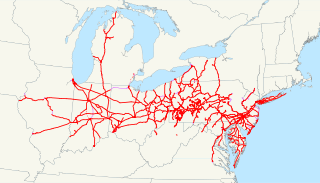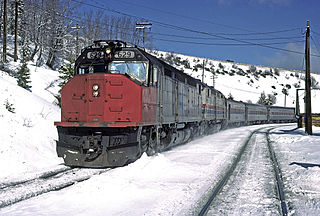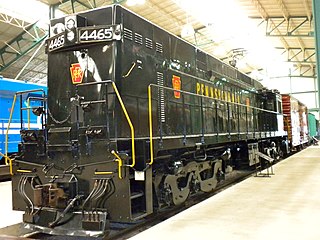
The Pennsylvania Railroad was an American Class I railroad that was established in 1846 and was headquartered in Philadelphia, Pennsylvania. It was so named because it was established in the Commonwealth of Pennsylvania.

The EMD F40PH is a four-axle 3,000–3,200 hp (2.2–2.4 MW) B-B diesel-electric locomotive built by General Motors Electro-Motive Division in several variants from 1975 to 1992. Intended for use on Amtrak's short-haul passenger routes, it became the backbone of Amtrak's diesel fleet after the failure of the EMD SDP40F. The F40PH also found widespread use on commuter railroads in the United States and with Via Rail Canada. Additional F40PH variants were manufactured by Morrison-Knudsen and MotivePower Industries between 1988 and 1998, mostly rebuilt from older locomotives.
General Motors Diesel was a railway diesel locomotive manufacturer located in London, Ontario, Canada. It was created in 1949 as the Canadian subsidiary of the Electro Motive Division of General Motors (EMD) located in the United States. In 1969 it was re-organized as the Diesel Division of General Motors of Canada, Ltd. The plant was re-purposed to include manufacture of other diesel-powered General Motors vehicles such as buses. Following the US-Canada Free Trade Agreement in 1989, all of EMD's locomotives were built at the London facility. In 2005 new owners of EMD renamed the Canadian subsidiary Electro-Motive Canada. The plant was closed by EMD's new owner Progress Rail Services in 2012, with EMD's production remaining in LaGrange, Illinois and Muncie, Indiana.

The E8 was a 2,250-horsepower (1,678 kW), A1A-A1A passenger-train locomotive built by General Motors' Electro-Motive Division (EMD) of La Grange, Illinois. A total of 450 cab versions, or E8As, were built from August 1949 to January 1954, 447 for the U.S. and 3 for Canada. 46 E8Bs were built from December 1949 to January 1954, all for the U.S. The 2,250 hp came from two 12 cylinder model 567B engines, each driving a generator to power the two traction motors on one truck. The E8 was the ninth model in the line of passenger diesels of similar design known as EMD E-units. Starting in September 1953, a total of 21 E8As were built which used either the 567BC or 567C engines.

The E9 is a 2,400-horsepower (1,790 kW), A1A-A1A passenger train-hauling diesel locomotive built by General Motors' Electro-Motive Division of La Grange, Illinois, between April 1954 and January 1964. 100 cab-equipped A units were produced and 44 cabless booster B units, all for service in the United States. The E9 was the tenth and last model of EMD E-unit and differed from the earlier E8 as built only by the newer engines and a different, flusher-fitting mounting for the headlight glass, the latter being the only visible difference. Since some E8s were fitted with this, it is not a reliable way to distinguish the two.

The EMD F9 is a 1,750 horsepower (1,300 kW) Diesel-electric locomotive produced between February 1953 and May 1960 by the Electro-Motive Division of General Motors (EMD) and General Motors Diesel (GMD). It succeeded the F7 model in GM-EMD's F-unit sequence. Final assembly was at GM-EMD's La Grange, Illinois plant. The F9 was also built in Canada by General Motors Diesel at their London, Ontario plant. A total of 101 cab-equipped lead A units and 156 cabless booster B units were built. The F9 was the fifth model in GM-EMD's highly successful "F" series of cab unit diesel locomotives.

The EMD FP9 is an American 1,750 horsepower (1,300 kW), B-B dual-service passenger and freight-hauling diesel locomotive that was produced between February 1954 and December 1959 by General Motors Electro-Motive Division, and General Motors Diesel. Final assembly was at GM-EMD's La Grange, Illinois plant, except for Canadian orders, which were assembled by Canadian subsidiary GMD at London, Ontario. The FP9 was essentially EMD's F9 locomotive extended by four feet to give greater steam generator and water capacity for hauling passenger trains. A total of 90 cab-equipped lead A units were built; unlike the freight series, no cabless booster B units were sold. Regular F9B units were sometimes used with FP9 A units, since they, lacking cabs, had more room for water and steam generators. The FP9 and its predecessor, the FP7, were offshoots of GM-EMD's highly successful F-unit series of cab unit diesel locomotives.

The EMD FL9 is a dual-power electro-diesel locomotive, capable of diesel-electric operation and as an electric locomotive powered from a third rail. Sixty units were built between October 1956 and November 1960 by General Motors Electro-Motive Division for the New York, New Haven and Hartford Railroad.

The SDP45 is a six-axle, C-C, 3,600-horsepower (2,680 kW) road switcher diesel-electric locomotive built by General Motors' Electro-Motive Division of La Grange, Illinois. It was a passenger-hauling version of the SD45 on a stretched locomotive frame with an extended, squared-off long hood at the rear, aft of the radiators, giving space for a steam generator for passenger train heating. This steam generator placement followed the pattern set by the SDP35 and SDP40.

The EMD SD50 is a 3,500-horsepower (2,610 kW) road switcher diesel-electric locomotive built by General Motors Electro-Motive Division. It was introduced in May 1981 as part of EMD's "50 Series", but prototype SD50S locomotives were built from 1980; production ceased in January 1986. The SD50 was in many respects a transitional model between EMD's Dash 2 series which was produced throughout the 1970s and the microprocessor-equipped SD60 and SD70 locomotives.
Progress Rail Locomotives, doing business as Electro-Motive Diesel (EMD) is an American manufacturer of diesel-electric locomotives, locomotive products and diesel engines for the rail industry. The company is owned by Caterpillar through its subsidiary Progress Rail.

The EMD SDP40F was a six-axle 3,000 hp (2.2 MW) C-C diesel–electric locomotive built by General Motors Electro-Motive Division (EMD) from 1973–1974. EMD built 150 for Amtrak, the operator of most intercity passenger trains in the United States. Amtrak, a private company but funded by the United States government, had begun operation in 1971 with a fleet of aging diesel locomotives inherited from various private railroads. The SDP40F was the first diesel locomotive built new for Amtrak and for a brief time they formed the backbone of the company's long-distance fleet.

An electro-diesel locomotive is a type of locomotive that can be powered either from an electricity supply or by using the onboard diesel engine. For the most part, these locomotives are built to serve regional, niche markets with a very specific purpose.

The passenger locomotives derivatives of the General Motors EMD GP40 diesel-electric road switcher locomotive have been, and continue to be, used by multiple passenger railroads in North America. For passenger service, the locomotives required extra components for providing steam or head-end power (HEP) for heating, lighting and electricity in passenger cars. Most of these passenger locomotives were rebuilt from older freight locomotives, while some were built as brand new models.

The PRR E44 was an electric, rectifier-equipped locomotive built by General Electric for the Pennsylvania Railroad between 1960 and 1963. The PRR used them for freight service on the Northeast Corridor. They continued in service under Penn Central and Conrail until Conrail abandoned its electric operations in the early 1980s. They were then acquired by Amtrak and NJ Transit, where they lived short lives; all were retired by the mid-1980s. One is preserved at the Railroad Museum of Pennsylvania.
Railroad electrification in the United States began at the turn of the 20th century and comprised many different systems in many different geographical areas, few of which were connected. Despite this situation, these systems shared a small number of common reasons for electrification.

T41 is a diesel-electric locomotive used by Swedish State Railways between 1956 and 1988 for secondary line services and later shunting. It was built in five copies by Nydquist & Holm (NOHAB) on licence from General Motors Electro-Motive Division.
The GM10B was a solitary testbed electric locomotive for freight duties built by General Motors' Electro-Motive Division of the United States in collaboration with ASEA of Sweden. It was built at EMD's La Grange, Illinois plant entering service in August 1976. Equipped with B-B-B trucks and a high proportion of Swedish ASEA design and technology, the locomotive was designed for high-speed freight service.

The EMD G22CU is a narrow gauge diesel-electric locomotive designed and built by the Electro-Motive Division of General Motors. It was manufactured by several licensees, and exported to many countries including Argentina, Australia, Brazil, Egypt, Iran, New Zealand, Nigeria, Pakistan, South Korea, Yugoslavia and Taiwan (ROC).
A locomotive or engine change is a location where a locomotive is exchanged for another locomotive.














